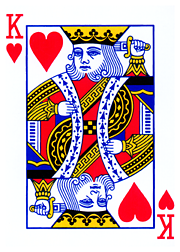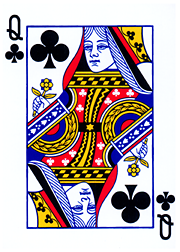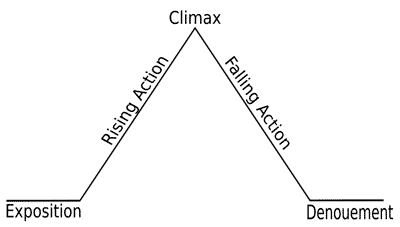
Source: Poker-sm-222-Kh, Wikimedia

Source: Poker-sm-243-Qc, Wikimedia
All writing needs to have a structure or a logical order. In fiction, plot provides the structure. The plot is the events of a story, set out in a way that usually depicts cause and effect. The novelist E.M. Forrester sums up plot like this: “The king died and then the queen died is a story. The king died and then the queen died of grief is a plot.” The story of the king and queen’s deaths could be told through many different plots: “The king was murdered, and the queen died trying to avenge him,” or “The king died, and then the queen died when she fell into the moat while celebrating the king’s death.” You can probably imagine other, equally fun examples.
In addition to cause and effect, a plot contains other elements that create structure in a story. A plot begins with exposition, in which the reader is introduced to the main characters and the setting. In the rising action, which follows exposition, the writer develops suspense and interest in the story by introducing the main conflict. The most dramatic part of the plot happens next, the climax. The main character faces a story's conflict head-on in the climax. The falling action follows and begins to tie the loose ends of the plot together. In the last part of the story, the conflict is resolved. This is the resolution, sometimes referred to as the dénouement. The resolution reveals what happens to the main characters after the conflict is resolved. The diagram below illustrates these elements of plot:

Source: Poker-sm-222-Kh, Wikimedia

Let’s do a short activity to review the elements of plot. Match each picture from “Little Red Riding Hood” to the closest corresponding plot point on the pyramid below.
Plots have momentum or a forward motion. In this lesson, we will isolate and discuss specific plot scenes from several works of fiction. You will learn how each scene moves the plot forward toward the resolution.